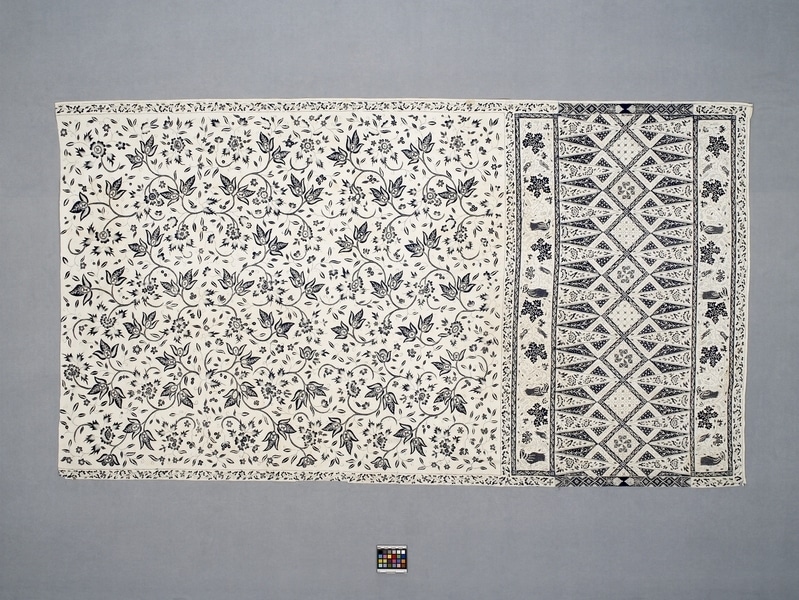Sarong Item Number: Ib379 from the MOA: University of British Columbia

Description
Rectangular cotton batik with blue pattern on white ground. Two patterns, one a third of textile. Pattern near one end has wide band of blue diamonds and triangles with flowers in them, bordered on two sides by maple leaf and cock motifs. The other pattern is of leaves and vines and smaller flowers on vines. Entire textile is bordered with vine motif.
History Of Use
Java is an important batik producing area. Although wax or paste resist dyeing is probably quite ancient on Java, the intricately detailed batiks on fine cotton cloth are relatively recent (16th century). The development of Javanese batiks is probably associated with a general flowering of the creative arts around the courts of the central princedoms of Surakarta and Jogjakarta. In Indonesia, textiles have great social and spiritual significance. They were exchanged and displayed in important ritual contexts. Traditional batik patterns and colour choices reflected local preferences and social distinctions. Local dyes could be distinguished and many patterns were restricted in use by rank, family and occasion. With the advent of the export trade, the relaxing of social restrictions, the introduction of chemical dyes and of batik manufacturing, many of these distinctions have disappeared.
Iconographic Meaning
The decorated triangles are called 'tumpal' an ancient symbol found all over Southeast Asia and India. The stylized birds are derived from Ming Dynasty porcelains and the flowing flower filler motifs may be derived from Hindu Javanese bronzes of the 12th century (Larsen).
Narrative
For the most part, Indonesian clothing is based on a rectangle, which is draped over the body or sewn in a tube. Additional rectangles are used for belts, mantles and head cloths etc. The size and pattern with kepala border suggests this cloth may have been worn as a sarong, although it is no longer sewn into the necessary tube.
Item History
- Made in Lassem, Java, Indonesia before 1980
- Collected before 1980
- Owned by Dorian Rae before October 31, 1980
- Received from Museum of Anthropology Shop Volunteers (Funding source) and Dorian Rae (Seller) on October 31, 1980
What
- Name
- Sarong
- Identification Number
- Ib379
- Type of Item
- sarong
- Material
- indigo dye and cotton fibre
- Manufacturing Technique
- cut, dyed and waxed
- Overall
- height 107.5 cm, width 193.5 cm
Who
- Culture
- Javanese
- Previous Owner
- Dorian Rae
- Received from
- Museum of Anthropology Shop Volunteers (Funding source) and Dorian Rae (Seller)
Where
- Holding Institution
- MOA: University of British Columbia
- Made in
- Lassem, Java, Indonesia
When
- Creation Date
- before 1980
- Collection Date
- before 1980
- Ownership Date
- before October 31, 1980
- Acquisition Date
- on October 31, 1980
Other
- Item Classes
- textiles
- Condition
- poor
- Accession Number
- 0677/0014